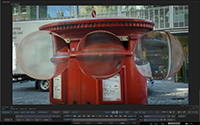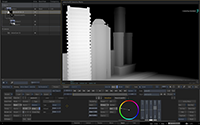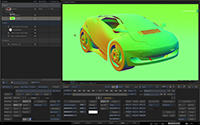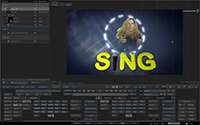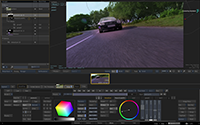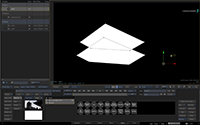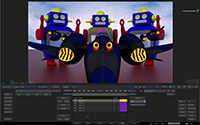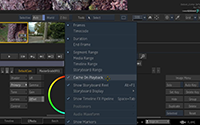What's New in Flame Family 2020
Welcome to the 2020 release of the Flame Family products!
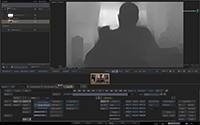
|
With Machine Learning-based AOV Generation and 3D AOV in Selectives, you now have unique ways to isolate and modify common objects in moving footage, for colour grading and compositing purposes. |
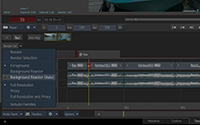 |
Background Reactor on single GPU, automatic background rendering, and Background Reactor optimizations allow you to keep moving without having to remember to send your work to render, using GPU and system capacity to its fullest. |
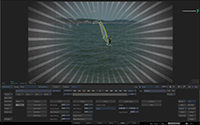 |
Open standards support that now includes more OpenFX, UDIM texturing, Cryptomatte render passes, and Python API help you work in a wide variety of post-production workflows. |
Additional information:
Many new feature videos (as well as other workflow videos) are available on the Flame Learning Channel. This channel is updated frequently, so be sure to subscribe.
Links to 2020 videos are denoted by this icon:

In this What's New topic,
 indicates a new feature or enhancement that was suggested and voted up by Flame Family users on the Feedback portal (also accessible directly from Product menu
indicates a new feature or enhancement that was suggested and voted up by Flame Family users on the Feedback portal (also accessible directly from Product menu  Help).
Help).Make sure to check out Flame Central, the hub for all your Flame Family links.
Looking for the Release Notes for Flame Family 2020? Click here: Flame Family 2020 Release Notes.
Welcome Screen
Want to get only the highlights of the release? Let the new Welcome Screen show you to the new features. It opens the first time you launch a Flame Family product.
Or access it anytime from Product menu  Help.
Help.
For details on all the new features and enhancements in this release, follow the links to navigate to the sections below:
- Action
- Action / Image
- Action / GMask Tracer / Image
- Archives
- Background Reactor (Linux Only)
- Batch
- Conform
- Effects Tab
- File Browser
- Formats Support
- MasterGrade
- Matchbox
- MediaHub
- OpenFX
- Project Management
- Pybox
- Python API
- Python Hooks
- Tangent Panels
- Timewarp
- Tokens System
- Tools
- Viewing
Action
Support for UDIM Texture
The UDIM texture format is now supported in Action. It includes support for TX, TXR, and TXT files.
See About UDIM Textures for more information.
Refraction
Located in the Material node, the new Refraction controls allows a transparent or semi-transparent object to refract its background. Using an index of refraction, you can simulate real world refraction.
Substance PBR Inverted IOR. Substance assets sporting an Inverted IOR are now supported. Five new Substance Translucent assets with an Inverted IOR value are now available in the Substance PBR library.
- glass_clear
- glass_rain
- glass_spectrum_ice
- glass_waterfall
Refraction-related Geometries. We added over ten new geometries to the FBX library for you to try out refraction.
See Creating Refraction for more information.
Other Improvements
 Viewport manipulator update. In this release, the viewport manipulator no longer appears when you use the Select tool to select points from an Extended Bicubic or Deform: it should help with the selection and multi-selection of vertices. You can still move vertices when you're in the Select mode, but the movement is limited to the plane of the current camera.
Viewport manipulator update. In this release, the viewport manipulator no longer appears when you use the Select tool to select points from an Extended Bicubic or Deform: it should help with the selection and multi-selection of vertices. You can still move vertices when you're in the Select mode, but the movement is limited to the plane of the current camera.
To edit the selected vertices in 3D space, switch to the Translate mode, where the manipulator allows 3D manipulations. Also the Select Points tool has been updated: it no longer displays the manipulator, and cannot move points anymore, allowing you to select points without fear of moving one (or many) accidentally.
Drag & Drop from Media Panel. You can now drag and drop a clip directly from the Media Panel to the Action Result view or the new Manager view. This automatically adds the media to the Action scene and creates a clip node in the Batch schematic. Drag & dropping a Matte Container, a BFXa or a multi-channel clip to the Manager view or the Action Result view automatically connects the Matte channel to the Matte input of the Media Input node.
Display Axis in Viewport. The new Axis option in the Viewing menu bar allows you to toggle On or Off the 3D Axis icons in the viewport.
Light Wrap in Action Particles. Action Particles now support Light Wrap.
Updated Material Node. The Material node now has a new Blending menu for Blending Mode, Transparency, and Refraction. Using a single Material node, you can set the Blend Mode for multiple objects. Simply enable the Active button, and any object (Surface, 3D Text, 3D Shape, Particle Generator, Geometry and Projector) connected to the Material node inherit the selected blend mode. The Transparency control moves from the Material tab to the Blending tab, as it is a control required by the new Refraction feature.
Machine Learning-based AOV Generation
 | 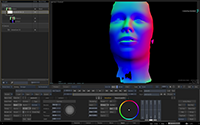 | 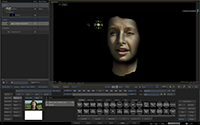 |
 Machine Learning - Part 1 - The Z-Depth Generator Machine Learning - Part 1 - The Z-Depth Generator |  Machine Learning - Part 2 - Detecting the Human Face Machine Learning - Part 2 - Detecting the Human Face |  Machine Learning - Part 3 - Human Face 3D Relighting Machine Learning - Part 3 - Human Face 3D Relighting |
You can now leverage machine learning-based algorithms to generate Z-depth from faces or clips, and Normal data from faces.
Use the Action Z-Depth map generate depth data for faces or clips. Use the Action Normal map to generate normal data for faces. Using these arbitrary output values (AOV), you can:
- Create a depth map and, together with a Selective node, create image segmentation using the depth data. Quickly create image isolation without first rotoscoping and tracking everything.
- Activate Displace Vertices in the Z-Depth map and create 3D information for the surface and then start adding lights or compositing in 3D space.
- Activate Z-Depth Pass in the Z-Depth map to provide depth data to Action's Z-Depth output. You can then use this data to do some post-processing on the depth of a scene.
- Create a normal map and, together with a Selective node, relight a face using generated normals data.
You can also perform normal and depth analysis from Batch FX using two new Matchboxes.
- MLDepth performs depth analysis to extract depth data from any image.
- MLFaceMaps can extract depth, normals, or UV data off of a human face in close-up shots.
For additional information about normals and Z-Depth generation, including best practices, see Using Face Analysis to Generate Normals, and Using Face and Global Analysis to Generate Z-Depth Data.
Action / Image
3D AOV in Selectives
heSelective object has a new menu: 3D AOV. This menu extracts a Matte out of an AOV data pass. For example, you can use a Distance mode to extract only the far plane of a scene, and then process it like you would process a Keyer or a GMask, using a Physical Bokeh or a MasterGrade Matchbox.
One can view the different Types of 3D AOV as types of 3D data keyers. While a classical keyer performs its segmentation by operating in the colour space of an image, the 3D AOV menu performs its image segmentation using spatial information. For this to work, you must provide the corresponding spatial information to the 3D AOV extraction mode. You provide this information by connecting to the Surface a texture map with the required 3D information.
For additional information, see Creating a Selective Matte From Data.
Other Improvements
Input Matte & GMask inversion. A new option in the Selective node allows you to invert the overall GMask result at once. For example, to be exclusive when working with a Keyer and multiple GMask shapes, you previously had to invert each GMask and deal with each GMask blending individually. Now you can simply work inclusively, and then invert the overall result at once using the Input Matte / GMask Invert button. This button is displayed in the Controls menu of the Selective node.
 Region of Interest. The Z-Depth, Normals and Motion Vectors maps have an expanded Region of Interest section. You can now display the ROI without first rendering it.
Region of Interest. The Z-Depth, Normals and Motion Vectors maps have an expanded Region of Interest section. You can now display the ROI without first rendering it.
Action / GMask Tracer / Image
More Room for Object Menus

 You can now have the Object menu display an expanded view of an object's controls. You can now to display both panels, expand the right panel, or expand the left panel. The following keyboard shortcuts can also be used to select the three options:
You can now have the Object menu display an expanded view of an object's controls. You can now to display both panels, expand the right panel, or expand the left panel. The following keyboard shortcuts can also be used to select the three options:
- Display Both Panels in the Object Menu: Alt-Shift-Down (all user profiles)
- Expand Left Panel in the Object Menu: Alt-Shift-Left (all user profiles)
- Expand Right Panel in the Object Menu: Alt-Shift-Right (all user profiles)
The following objects have been updated and have a new layout in the expanded Object menu.
| Objects | Maps | |
|---|---|---|
|
|
|
Manager
You now have access to a new Action view: the Manager.
The Manager provides you with a clear listing of all the objects found in an Action scene, organized in a hierarchy that mirrors the Action schematic. It reduces the complexity of a scene by making it easier to identify and select an object using its name. The Action Schematic remains at the heart of Action for object connections and relationships. The Manager simplifies everything else.
See About the Manager View for additional information.
Other Improvements
Hidden Camera widgets. Camera widgets can be individually hidden with the Icons button located in the Camera's Display menu.
Archives
Archive Table of Contents Format Change
The format of the Table of Contents files (TOC) changes in Flame Family 2020.
For additional information, see TOC Changes.
Generate HTML/XML Table of Contents
 You can now create an HTML Table of Contents when archiving. Enable the option Generate TOC in the Archives browser.
You can now create an HTML Table of Contents when archiving. Enable the option Generate TOC in the Archives browser.
Use the HTML TOC to view the contents of the archive using a web browser. The HTML file is created in /opt/Autodesk/archive/<archive name>/<archive name>/.
CLI tool creates HTML TOC. The Flame Archive command-line tool can now be used to generate the HTML table of contents. For more details, enter at the command line: /opt/Autodesk/io/bin/flame_archive -h or see Command Line Archive & Restore
Background Reactor (Linux Only)
Background Reactor on Single GPU
You can now use Background Reactor on single-GPU configurations. If you're on Linux, it is now activated by default. Just use the Background Reactor option from the Rendering button.
For important configuration information, see the configuration guide.
Automatic Background Rendering
When working in the Conform/Timeline, Effects, or Batch FX environments, you can use a new option named Background Reactor (Auto).
Background Reactor (Auto) automatically sends unrendered Transitions & Timeline FX to Background Reactor. This happens whenever you change shot, similar to how Lustre Shot Reactor works. You enable the option in the Rendering drop-down menu.
For additional information, see Background Reactor.
Background Reactor Optimizations
Did you say faster? This release improves on Background Reactor's reactivity, with tasks being picked up and sent for processing even faster than before, with notable improvements in the case of long form projects. Of course, the actual rendering depends on your graphics card.
Stop on leave. When a user leaves a Flame Family product while Background Reactor is running, a stop command is sent to the Backburner Manager. This command ensures that once all relevant tasks are completed, the Background Reactor services stop.
Load On-demand. Background Reactor no longer starts when a Flame Family product starts. It now only starts when you change the Render Option menu from Foreground to Background Reactor (either Auto or manual options). This ensures a better control over Background Reactor resource consumption.
Playback Protection mode. When performing Playback, background tasks such as caching, media export, Burn and Background Reactor are paused to protect real-time playback. A new Preference named Protect Playback has been added in the General > Background Tasks section so user can disable this option if they want background tasks to continue while playing back content.
Only render what's current. If you modify a Timeline FX already sent to Background Reactor for rendering, that background task is cancelled to avoid rendering a Timeline FX that is now obsolete. That being said, if you delete a Timeline FX being rendered with Background Reactor, that background task is not canceled and is allowed to finish. This is ensures that if you undo the deletion of the Timeline FX, you do get back the Timeline FX and its cached media.
Cancels quickly. Background tasks are now cancelled more effectively, especially when there's a large amount of such tasks to cancel.
Batch
Include Setup without Open Clip. You can use the Write File node and export the Batch setup without having to also create an Open Clip.
 Cryptomatte as a Batch Node. You now have a ne w Batch node called Cryptomatte. This new node extracts Mattes out of Cryptomatte data passes. It has seven inputs: one for the Front input and six for the three RGBA crypto matte data passes.
Cryptomatte as a Batch Node. You now have a ne w Batch node called Cryptomatte. This new node extracts Mattes out of Cryptomatte data passes. It has seven inputs: one for the Front input and six for the three RGBA crypto matte data passes.
For additional information, see Cryptomatte.
Conform
FCP 7 markers. Markers from Apple Final Cut Pro 7 (.xml) sequences are now supported. Flame can translate marker name, colour, duration, and comments.
AAF Markers duration. Support for marker duration data from AAF generated by Avid Media Composer markers. This is in addition to other marker information already supported (name, colour, comments).
AAF Compositions from Adobe Premiere Pro. While Flame Family products still do not support Adobe Premiere Pro compositions, we have fixed issues related to Flame Family products crashing when importing AAF sequences from Adobe Premiere Pro.
Consecutive transitions found in an Adobe Premiere Pro FCP XML composition should now conform more accurately.
Pattern browsing and multi-versions. You can now use Pattern Browsing with Set Search Location without running into duplicate matches for Multi-Versions content.
Saturation data in EDL and AAF. When conforming an EDL or AAF composition with ASC CDL data, any Saturation data written inside parenthesis now creates a Look FX in the Flame Family products. In previous application, no Look FX would have been created.
Some applications create ACS CDL data using the Avid Log Exchange (ALE) format. The ALE format uses parenthesis for Saturation, something that is not supported by the ASC CDL specifications. While this type of CDL is available in Avid Media Composer, it will not produce accurate CDL values when used as Source Settings. But you can still export it as an EDL or an AAF that can be read correctly in the Flame Family products.
Connected Segments Shortcuts. Keyboards shortcuts are now available for the following Connected Segments functions. You'll have to assign them a each a keystroke in the Application menu  Keyboard Shortcuts.
Keyboard Shortcuts.
- Create Segment Connection
- Create Source Segment Connection
- Remove Segment Connection
- Duplicate Connected Segment
- Duplicate Source
- Sync From Connected Shot Sequence
- Sync From Connected Sequence Segment
Effects Tab
Cache on Playback. You can now enable Cache On Playback in the Effects tab. This new option is located in the Options menu next to the playback controls. It is independent from the similar Timeline option.
Timeline FX rendering status on Storyboard Reel. In Effects, the render state of a segment is now displayed at the top of its thumbnail on the Storyboard Reel. It uses the same colour coding as the Timeline environment:
- White: Unrendered FX
- Black: Rendered FX
- Black dots: Partially rendered FX
- Orange: Proxy rendered FX
- Orange dots: Partially proxy rendered FX
Show or Hide. You can show or hide the render status from the Storyboard Display. From the Options drop-down box next to the Playback functions, Storyboard Display  Render Status.
Render Status.
File Browser
Sort by Date or Name. You can now sort the Tiles view of the File Browser by date or name. Select the sort option from the Gear or context menus.
Sort by name, not by capitalization. The Tiles view no longer considers capitalization of a tile's name when sorting tiles together. This is now identical to how the sort performs in the List view.
Formats Support
Media Import
Sony VENICE 3.0. This release supports Sony VENICE firmware 3.0 (RAW SDK 3.2 and SMDK 4.17.0). This update includes support for:
- New resolutions: 5.7K (16:9) and 6K (2:39)
- New X-OCN XT compression
- De-squeeze for x1.25, x1.3, x1.5 and x1.8)
- User Define XDROOT folder naming
- For more details on Sony VENICE firmware 3.0, see Sony documentation.
RED Update. The RED SDK was updated to version 7.0.8, and fixes the issue related to RED media decoded in ACES colour space.
Pixel ratios. New pixel ratios are now available from the MediaHub (General > Pixel Ratio):
- 1.25 (for Panavision Anamorphic lenses)
- 1.5 (for P+S Technik Anamorphic lenses)
- 1.8 (for Cooke Anamorphic lenses)
Resizing Open Clip and Pattern Browsing. You can now modify Pre-Processing options for Pattern Browsing or Open Clip contents imported with a resize.
High Frame Rate. Non-supported frame rates, such as 48fps or 100 fps, are now imported using the project frame rate, with the correct duration.
OpenEXR
OpenEXR 2.3.0. We've updated the OpenEXR SDK to version 2.3.0. This updated SDK includes major bug fixes, and you should see better playback performance.
First Part as Beauty pass. A new OpenEXR option (in Clip Options) allows you to use the First Part of a multi-channel sequence as the main channel (beauty), instead of using the first RGBA layer or part. Nuke V11.3 introduced a new Write File option that defines the First Part in a multi-channel OpenEXR files. When importing such a file in Flame, disable Show RGBA First to use this First Part as the beauty.
TIFF
Improved TIFF 32-bit. Flame Family now supports 32-bit floating-point TIFF files. You should also see improved TIFF files playback performance (across the board, not just 32-bit fp.)
Planar TIFF. You can now import TIFF files set to planar configuration. Some renderers and post-processing tools generate TIFF file sequences in planar configuration instead of the interleaved configuration.
- Interleaved configuration: The component values of each pixel are stored contiguously. For example, for RGB data, the data is stored as RGBRGBRGB.
- Planar configuration: The components are stored in separate component planes. For example, RGB data is stored with the Red components in one component plane, the Green in another, and the Blue in another.
Media Export
Avid DNxHD/HR Colour space. Exported DNx files in a QuickTime wrapper now include colour space metadata, Rec.709 or Rec.2020 for DNxHR, Rec.709 for DNxHD.
Link Media can copy. Exporting with Link Media option now copies the original file if it cannot be linked to. This will happen when you export to a different file system location. You can use the Link Media option to export DPX or OpenEXR files and preserve the original media file header metadata.
QuickTime source Colour Space. QuickTime files exported from content tagged ARRI Log-C now show the colour space of the source content. This data can be read in third-party applications such as Final Cut Pro 10.4.4 and The Foundry Nuke.
Composition name. When you publish a sequence as an AAF or an FCP XML, you can now give a composition name to your sequence. You do this in the Sequence Options tab. Some third-party applications will use the composition name instead of the filename of the AAF/FCP XML.
Export Sony XAVC as Rec.2020. When you export media as Sony XAVC in an MXF container, you can now set the colour space to Rec.2020. This data is also read when importing media files.
Poster Frame Export. You can now export a single frame of a clip with the new Poster Frame option in Media Export (File Sequence). You can specify the frame to export (default is 1).
MasterGrade
Expanded UI. An expansive new layout is now available in the expanded version of the Matchbox node in Action and Image. This new layout displays all of the colour wheels of the Primary or Tone menus.

New unified menu. In addition to the new expanded layout, the new Prim/Tone menu unifies the Primary and Tone controls. With the Primary controls displayed in the collapsed view, if you expand the panel, it displays the expanded Primary controls; the same goes with the Tone controls. You can define what the tool displays when expanded: enable the preference TL FX / Batch /BFX  Mastergrade
Mastergrade  Favour Prim / Tone Menu.
Favour Prim / Tone Menu.
Tweaking the Expanded UI. We have tweaked the layout of the expanded user interface:
- The vertical sliders were made taller by shrinking the header labels.
- The Effect % and Outside settings of the Shader menu are now available from the Primary menu, in the Post-Processing section.
Updated Tangent Mapping. The MasterGrade mapping for the Tangent Control surfaces has been updated. Primary/Tone and Expand/Collapse options have been mapped to Tangent control surfaces.
- Panel: Map Go to Start / End on Wave panel.
- The Previous / Next Clip keys (I< and >I) can now be used to navigate Go to Clip Start / End (ALT mode).
Use the Tangent mapper application to remap these new controls:
- MasterGrade:
- Prim / Tone with Primary Panel Mode
- Prim / Tone with Tone Panel Mode
- Action:
- Display Both Panels in the Object Menu
- Expand Left Panel in the Object View
- Expand Right Panel in the Object View
 Tone controls in Tangent Panels. You can now control the Tone values even when the Tangent Panel is set to the Primary mode. The mapping is already done and is available to any new User Profile. See the Tangent Panels section for more details.
Tone controls in Tangent Panels. You can now control the Tone values even when the Tangent Panel is set to the Primary mode. The mapping is already done and is available to any new User Profile. See the Tangent Panels section for more details.
Matchbox
 Expanded UI. The Matchbox node's user interface is now consistent with the Action / GMask Tracer / Image expanded Object menu.
Expanded UI. The Matchbox node's user interface is now consistent with the Action / GMask Tracer / Image expanded Object menu.
- The Pages are now buttons displayed on the left of the UI, instead of tabs at the top.
- The Shader Selection, Input Configuration, and Canvas Resolution sections are all moved to the new Shader submenu.
- The number of columns in a page has been increased from 4 to 6.
Matchbox/Lightbox XML. The XML now supports the expanded UI. For additional information, see the Shader Builder documentation.
 New filter at Load. New options named Matchbox & GLSL and Lightbox and GLSL are available, and selected by default, in the Matchbox and Lightbox Load Shader file browsers. This option allows both the .glsl and .mx / .lx files to be displayed at once.
New filter at Load. New options named Matchbox & GLSL and Lightbox and GLSL are available, and selected by default, in the Matchbox and Lightbox Load Shader file browsers. This option allows both the .glsl and .mx / .lx files to be displayed at once.
Levels in FX Ribbon. The Popup button located in the Matchbox Timeline FX Ribbon now has a Page level that makes it easier to distinguish the different sub-menus.
New Lightbox shaders. There are two new Lightbox shaders:
- The CDL shader is exactly the same as its Matchbox counterpart
- The Linear Grade offers the same MasterGrade Scene Linear Primary processing, but in a format that's more compact.
New utility shader. SelectiveMatteExtraction is a new Matchbox shader that extracts the Matte of a Selective node, and makes it available as an Action output pass. For more information, see SelectiveMatteExtraction.
MediaHub
 The R key is now assigned to Refresh the MediaHub Folders and Files in every Flame user profile.
The R key is now assigned to Refresh the MediaHub Folders and Files in every Flame user profile.
 New Refresh button. A Refresh button is now available next to the Scan Subdirectories button. The Refresh button, shortcut, and context menu entry can be used while Scan Subdirectories is enabled.
New Refresh button. A Refresh button is now available next to the Scan Subdirectories button. The Refresh button, shortcut, and context menu entry can be used while Scan Subdirectories is enabled.
OpenFX
OpenFX support has been extended to even more plugins. Filters, General, and Generator plugins now appear in the Plugin drop-down menu.
In Batch, the sockets required by an OpenFX are now dynamically updated based on the selected plugin.
Support for Transition plugins.Transition plugins are now supported in Batch and the Timeline.
- In Batch
- The plugin can be loaded in the OpenFX node.
- Timeline
- The plugin can be applied as an OpenFX Timeline FX on a Timeline segment. In this scenario, the transition is made between the segment and the segment below. No keyframes are added, but the settings that are usually animated when the plugin is loaded as a transition are set to 50% of their value.
- The plugin can be applied as a video transition using the new OpenFX transition type. In this scenario, the transition is made between the outgoing and incoming segments. An animation is created by default.
Exception list. It is possible for OpenFX plugins to crash a Flame Family application at startup. If this happens, you can manually add the OpenFX plugin bundle name to the cf_ofx_ignore_list.cfg file located in /opt/Autodesk/presets/
Project Management
User profile on remote system. A Flame user profile located on a remote host is now persisted between sessions.
Reorganized Resolutions
The flat Resolutions list has been redesigned from the ground up to.
- The project's resolution is now always at the top of the list, for a quick access.
- Resolutions are now organized in categories: Broadcast, Film, DCP, and popular cameras manufacturers.
You can also add custom resolutions to the list.
For more information, see About the Resolution Box.
Pybox
The Pybox node's user interface has been modified to be consistent with the changes made in Matchbox.
- The Pages are now displayed as buttons on the left side of the user interface instead of tabs at the top.
- The Handler Selection and Canvas Resolution sections have been moved to a Handler sub-menu.
- The number of columns in a page has been increased from 4 to 6.
Python API
Expanded API. The following objects, properties, and functions are now part of the Python API.
<PyObject>.parent: Attribute. Every PyObject can now know its parent.flame.import_clips(): A new parameter allows you to specify where to import the clip.
More Batch nodes:
- Clamp node
- Auto Matte node
- Average node
- Burn-in Letterbox node
- Deal node
More Action functions:
- <PyActionNode >.import_fbx()
- <PyActionNode>.create_node()
- <PyActionNode>.export_fbx()
More examples. The following example files have been added to the /opt/Autodesk/
clean_batch_iteration.pycache_motion_vectors.pyimport_using_qt_file_dialog.py
For additional information, see the Python API documentation.
Python Hooks
Python hooks get_media_panel_custom_ui_actions() and get_main_menu_custom_ui_actions() have been modified: they are now easier to set up.
 Moving hooks. The custom actions hooks have been moved from the
Moving hooks. The custom actions hooks have been moved from the hook.py file to a new custom_actions_hook.py file. It now includes new custom action hooks.
Hide hooks from the UI. New parameters in the different custom actions hooks allow you to hide or disable actions.
PEP8 Python Standard. The files in /opt/Autodesk/
New examples. New python hook examples are available in /opt/Autodesk/flame_2020/python_examples.
Versioning Custom Hooks. You can now restrict a custom hook or action to a specific version of the Flame Family.
For additional information, see Python Hooks.
Tangent Panels
Updated mappings. The following changes were made to the Tangent panels mappings. You need to create a new user profile to have access to these improvements.
Arc panel:
- Navigation module: Transitions on page 3 now accommodates the addition of OpenFX transitions. Press
to see the updated mapping.
Element panel:
- BT module: OpenFX transitions are now available on page 4.
Control Tone from Primary. The Tone controls can be modified when the panels are displaying the Primary mode.
- Tangent Arc, Element and Wave mappings have been modified to allow Tone controls in Primary mode (Log, Scene Linear and Video for Primary, Selectives and Output).
- S-contrast, Pivot (Log and Scene Linear) and Saturation are now available as a group on all panels in Primary modes.
- Tone Controls are available on next pages in Primary modes on the Arc and the Element.
Timewarp
Ludicrous speed. Timewarp's maximum speed value is now 20 000% faster, upgraded from 10000% to 2000000%.
Tokens System
 A new Resolution token is now available in the following areas:
A new Resolution token is now available in the following areas:
- Segment Name
- Shot Name
- Media Export
- Write File node
The
Tools
Hard Commit and history. When using Hard Commit, Clip History is now correctly deleted on content without Timeline FX.
Duration in frames. The value of the Repeat Tool Duration field is now displayed in Frames when the preference User Interface  Time Display Mode is set to Frame.
Time Display Mode is set to Frame.
Viewing
The Viewport Diagnostics tools (Exposure, Contrast, Gamma) Bypass now automatically deactivates when one of the Diagnostic controls is modified using a keyboard shortcut.

